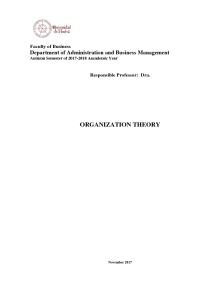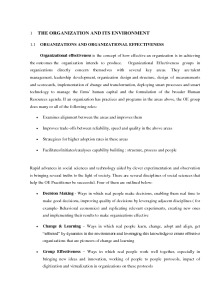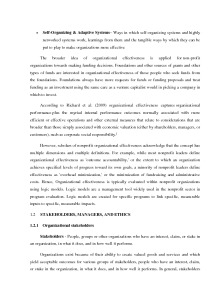The Organization And Its Environment



The organization and its environment. Organizations and organizational effectiveness. Change & Learning. In a Changing Global Environment. ORGANIZATIONAL DESIGN Basic Challenges of Organizational Design Designing Organizational Structure Authority and Control. Organizational change types and forms of organizational change. Planned vs. Unplanned Change. Episodic vs. Continuous Change. Organizational Transformations Birth , Growth , Decline , and Death Organization Birth. Stages and the Growth Cycle. Organization Decline , Renewal and Death. Decision Making , Learning , Knowledge Management Knowledge. Knowledge Management Processes and Goals. Innovation , Intrapreneurship , and Creativity. Managing Conflict , Power , and Politics.
Creativity is the generation of new ideas that meet perceived needs or respond to opportunities for the organisation (Daft & Noe, 2001: 116); it is the production of novel and useful ideas by an individual or team within organisation (Hellriegel et al., 1998: 458). Creativity affects products and services and processes in all areas of human activities (Amabile, 1997: 40). It is a decision-making processresulting in new useful ideas. Accordingly, organisational innovation is the implementation of creative and useful ideasthrough unplanned and planned organisational change (Muller, 1995: 16-19). Authors define the creativity process in a similar way. For Schermerhorn and his co-authors, (2000: 362) the process consists of:
• gathering the additional information on the problem and opportunity;
• searching for ideas to resolve the problem or utilise the opportunity;
Innovation is widely recognised as one of the critical problemsfacing businesstoday. The process of innovation starts with the best idea produced by the creation process. It continues with the design of a product or service and process (Rozman, 2002: 124). A thorough feasibility analysis follows to determine whether the solution is feasible (Does the company have employees, material and other resources? Is a market available, etc.?). The last step is the verification of success (Will the innovation be profitable?). Following that, the implementation and control start. Similarly, Tidd, Bessant and Pavitt (2001: 52) determine the process as:
• selection of best solution, feasibility study and verification of success;
Entrepreneurship is defined as a process or activity in which the entrepreneur makes an investment by risking his own money and name. Creativity and innovation and taking risk are also at the core of intrapreneurship. As already mentioned, large corporations have to make different changes to remain entrepreneurial. One of them is internal entrepreneurship or intrapreneurship, which issimilar to the entrepreneurship at the level of enterprises. Drucker (1992: 177-191) looks at intrapreneurship as spreading the entrepreneurial spirit within the enterprise thus making the ground for creativity and innovation.
Via intrapreneurship, motivation and support are given to creative and innovative employees to develop ideas and to turn them into products and services. The existence of intrapreneurship shows the inclination of the corporation toward innovation (Rutherford & Holt, 2007: 429-446). Some authors emphasise the importance of organisational culture and structures (e.g. Hornsby et al., 2002: 253-273) as well as management (e. g. DeYong & Hartog, 2007: 41-64) for the development of intrapreneurial units. At this point, the discussed organisational phenomena and their influences on creativity and innovation are obviously correlated and intertwined.
- Management Papers
- Microsoft Word 182 KB
- 2018 m.
- English
- 14 pages (4917 words)
- University
- Vilmante

















